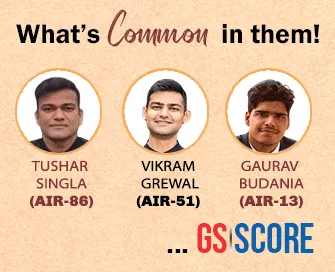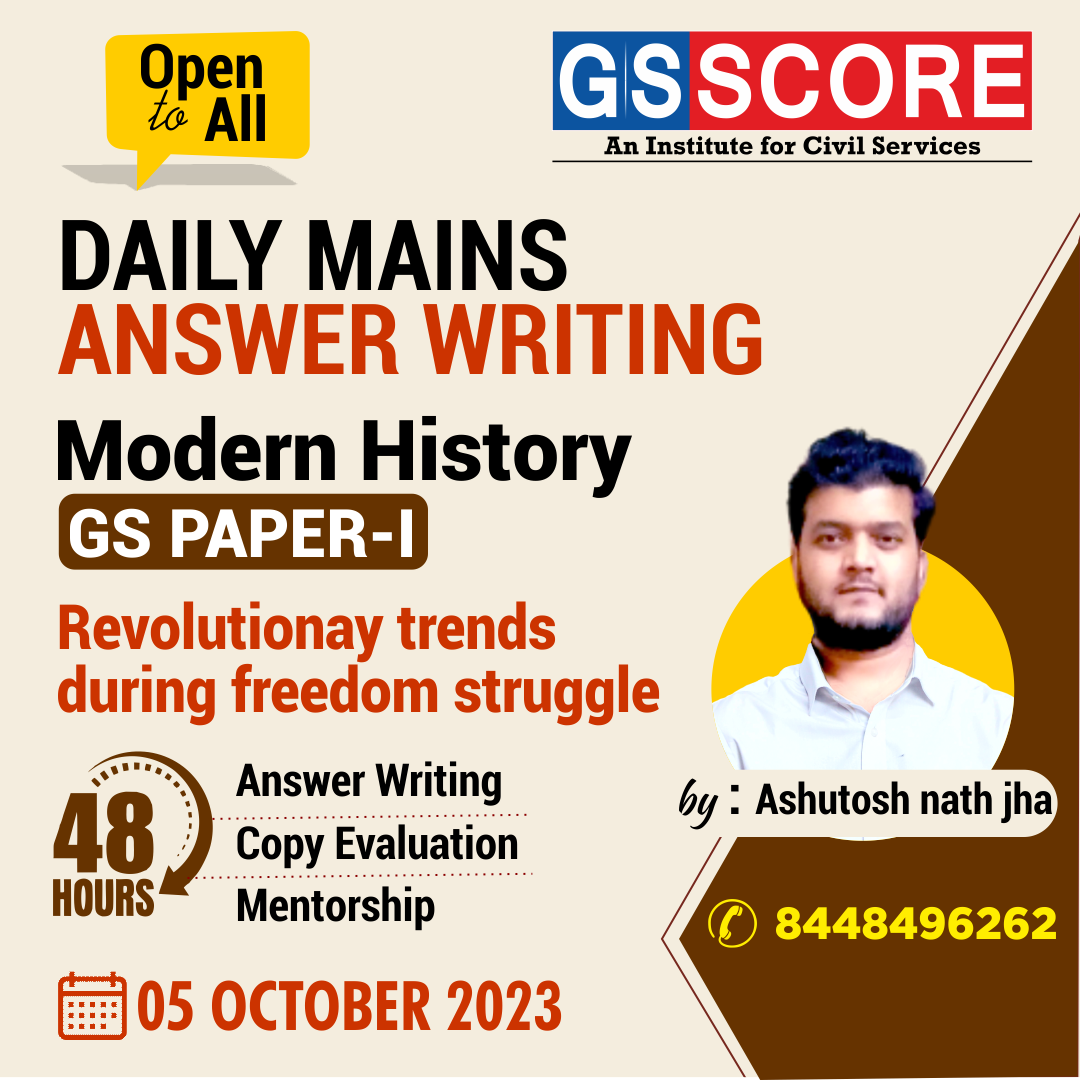


Instruction:
- There will be 2 questions carrying the First Question is-10 marks Write your answers in 150 words and the Second Question is-15 marks Write your answers in 250 words.
- Any page left blank in the answer-book must be crossed out clearly.
- Evaluated Copy will be re-uploaded on the same thread after 2 days of uploading the copy.
- Discussion of the question and one to one answer improvement session of evaluated copies will be conducted through Google Meet with concerned faculty. You will be informed via mail or SMS for the discussion.
Question #1. Discuss the ideologies and activities of revolutionaries before and during the first World war in India and abroad and Assess their role in the nationalist movement. (10 marks, 150 words)
Question #2. Examine the reasons for emergence of new forces of revolutionary activities and their ideological trends in the decade of 1920’s. (15 marks, 250 words)
(Examiner will pay special attention to the candidate's grasp of his/her material, its relevance to the subject chosen, and to his/ her ability to think constructively and to present his/her ideas concisely, logically and effectively).
STEPS & INSTRUCTIONS for uploading the answers
Step 1 - The Question for the day is provided below these instructions. It will be available at 7:00 AM.
Step 2 - Uploading of Answers : Write the answer in A4 Sheet leaving proper margins for comments and feedback and upload the PDF in MY ACCOUNT section. Click on the option of SUBMIT COPY to upload the PDF.
Step 3 - Deadline for Uploading Answers: The students shall upload their answers by 7:00 PM in the evening same day. The first 50 copies will be evaluated.
Step 4 - Feedback : Mentors will give their feedback for the answers uploaded. For more personalised feedback, join our telegram channel by clicking on the link https://t.me/mains_answer_writing_cse . A one-to-one session will be conducted with the faculty after copy evaluation in 72 Hrs.
Model Answer
Question #1. Discuss the ideologies and activities of revolutionaries before and during the first World war in India and abroad and Assess their role in the nationalist movement. (10 marks, 150 words)
Hints
Revolutionaries were the groups who believed in struggle against the colonial might with arms and revolutionary strength. These groups came in the backdrop as fall out of open and moderates movements like swadeshi and on cooperation zeal.
The nationalist favor, and revolutionary zeal of theirs was trying to find a channel to which they can source their energy which they ultimately found in the realization that colonial might of British can only be fought with involvement of masses and revolutionary approach.
Ideology
- Masses can be included with sacrifices made by revolutionaries and this may awaken their core to fight of the choke of British colonial rule. Finding all modes of political agitations closed to them or either faced severe repression by British, they thus thought that if the nationalist goal of independence is to be met, the British must be expelled by force. So this ideology was the guiding factor behind their struggle with imperialistic and colonial force of British.
- One more linkage can be drawn here, in the absence of any Indian rulers or authority or even organization which can include mass or even violent ideological stand against foreign rule, they believed it is the masses and rise of violent struggle which can create fear in the minds of oppressor.
- They opted to follow footsteps of Russian nihilists and Irish nationalists. They conducted raids, attacks on those which symbolizes British authority. The idea was to strike terror in the hearts of the rulers, arouse people and remove the fear of authority from their minds. This removal of authority was important to create fearless cadre.
Revolutionary organization and activities in India
- Formation of secret societies like the Anushilan samiti "Mitras" or mitra mela and "Yugantar" to promote revolutionary activities.
- They also did Extensive networking and recruitment of like-minded individuals within and outside India. E.g. Zimmerman plan. Further the Dissemination of revolutionary ideals through pamphlets, newspapers, and literature.
- Prominent publications like "Bandemataram" by Aurobindo Ghosh and "Vande Mataram" by Bankim Chandra Chattopadhyay served as rallying cries for revolutionaries.
- Targeted assassinations of British officials, including assassinations like that of Sir Curzon Wyllie by Madan Lal Dhingra.
- In Maharasthra, famous chapekar brother assassinated poona plague commissioner Rand. Further the mitra mela, a secret society which later merged with abhinav bharat emerged as main trends and stakeholders in revolutionary activities.
- In Punjab, Anjuman-i-Mohibban –i-watan, a revolutionary organisation was organised by Sardar Ajit singh with its journal Bharat mata. So these were having both-activists form ideological spread.
Revolutionary activities in abroad
- Setup of India home rule league by Shyamji Krishna Varma in London. Also he started journal called Indian sociologists. It passes resolutions condemning arrests in India and advocating for India's total independence.
- Berlin committee for independence, 1915-to mobilise the indian settlers aborad to send volunteers and arms to India to incite rebellion among Indian troopsand even to organised the arm invasion of British India.
- Missions of Indian revolutionaries were sent to Baghdad, Turkey, Persia for the cause of India’s independence and to work among Indian troops and prisoners of war to incite anti-British feelings.
- In 1913, the Ghadar revolutionaries - Punjabi immigrants who had settled on the West Coast of North America in 1904. Under the leadership of Lala Hardyal, Prominent figures like Bhai Parmanand and Harnam Singh 'Tundilat' were also part of the gathering. The newspaper- Hindustan Ghadar in Urdu and Gurumukhi, weekly compilation-Ghadar ki Goonj. Activities- assasinations of officials, publishing revolutionary ideas, anti-imperialist literatures, and work among troops in abroad, procure arms and bring revolts in all British colonies.
Assessment of Their Role in the Nationalist Movement
- Raised nationalist consciousness: Revolutionaries played a crucial role in awakening the nationalistic spirit among Indians. Their daring acts and sacrifices inspired many to join the freedom struggle.
- Shifting British Focus: diverted British attention and resources away from the mainstream Indian National Congress-led political struggle. The British had to allocate significant resources to counter the revolutionary threat.
- Contributing to Radicalization: more radical approaches to achieve independence, influenced the political discourse and strategies of the Indian National Congress.
- International Attention: garnered international attention and support for India's struggle for independence. Contacts abroad facilitated propaganda and fundraising efforts.
- Sacrifices and Martyrdom: revolutionaries became martyrs for the cause of independence, inspiring future generations. Bhagat Singh, Chandrashekhar Azad, and others continue to be revered figures in Indian history.
The revolutionaries before and during the First War in India and abroad played a significant and multifaceted role in the nationalist movement. While their methods were often radical and confrontational, they contributed to raising awareness, shifting British policies, and inspiring future generations of nationalists. The early revolutionary phase eventually merged with the broader Gandhian-led non-violent movement. Their sacrifices and dedication remain an integral part of India's struggle for independence.
Question #2. Examine the reasons for emergence of new forces of revolutionary activities and their ideological trends in the decade of 1920’s. (15 marks, 250 words)
Hints:
The decade of the 1920s witnessed the emergence of new forces of revolutionary activities in India, characterized by shifts in ideological trends and strategies.
Ideological trends
The overarching ideology of most revolutionary movements was a fervent opposition to British colonial rule. They believed in the complete independence of India from British imperialism. They were influenced by socialist and Marxist ideologies. They believed in the redistribution of wealth, land reforms, and the elimination of social and economic disparities. Bhagat Singh, for instance, was known for his socialist leanings.
Patriotism and a deep love for the motherland were central to the ideology of Indian revolutionaries. They saw their struggle as a means to restore India's past glory and achieve a united, sovereign nation.
Revolutionaries often transcended religious boundaries in their struggle and worked towards a secular and inclusive India.
Revolutionaries believed in direct action, including armed resistance, bombings, and assassinations, as a means to achieve their goals. They sought inspiration and support from international anti-imperialist and socialist movements. They believed in the interconnectedness of global struggles against colonialism and capitalism. There was also a trend of celebrating and reviving India's rich cultural heritage and history
Several factors contributed to this evolution:
Rise of newer ideas
- After the First World War, there was a notable increase in the emergence of a new class of trade union workers. These individuals were increasingly seen as having significant revolutionary potential by nationalist revolutionaries.
- The revolutionaries aimed to channel the energy and influence of this growing working-class population into the broader nationalist revolution. This recognition of the power of the working class marked a strategic shift in the approach of many nationalist movements, as they sought to mobilize and unite different segments of society in their struggle for independence and social change.
Influence of Gandhian Non-Cooperation Movement:
- The Gandhian-led Non-Cooperation Movement, launched in the early 1920s, played a pivotal role in shaping the revolutionary landscape.
- Many young activists were initially drawn to Gandhian non-violence and mass mobilization tactics. However with the early and pre mature withdrawal of this led to dissatisfaction and still the revolutionary zeal was firing underneath.
Disillusionment with Moderate Politics:
- The failure of the Lucknow Session of the Indian National Congress in 1916 to secure significant constitutional reforms left many nationalists disillusioned with the moderate political approach.
- Discontentment with the Montagu-Chelmsford Reforms of 1919 further fuelled radicalism.
Influence of International Events:
- The aftermath of World War I and the Russian Revolution of 1917 had a global impact.
- The Russian Revolution, in particular, inspired Indian revolutionaries with its successful overthrow of autocracy.
Influence of Socialist and Communist Ideals:
- Socialism and communism gained popularity among Indian revolutionaries in the 1920s.
- The Bolshevik Revolution in Russia and the writings of Marx and Lenin influenced many to adopt socialist ideologies.
- The formation of the Communist Party of India (CPI) in 1920 marked the formal entry of communism into Indian politics.
Radicalization and Militancy:
- The 1920 Chauri Chaura incident, where protesters turned violent, led to a temporary suspension of non-cooperation by Gandhi. This radicalized some activists who sought more direct methods.
- Revolutionary groups like the Hindustan Socialist Republican Association (HSRA) adopted militant tactics.
Economic Distress and Agrarian Unrest:
- Economic hardships, agrarian distress, and the burden of heavy taxation fueled discontent among peasants and workers.
- Leaders like Bhagat Singh and Chandrashekhar Azad emerged from this context, advocating for a more militant approach.
Emergence of New Leaders:
- The 1920s saw the rise of new leaders like Bhagat Singh, Chandrashekhar Azad, and Subhas Chandra Bose.
- These leaders had a more radical and militant outlook compared to the earlier generation of leaders.
Regional Movements:
- Various regions, such as Bengal and Punjab, witnessed intense revolutionary activities.
- The Moplah Rebellion in Malabar (1921) and the Kakori Conspiracy (1925) were regional manifestations of this radicalism.
Repressive Measures:
- British repression and the execution of prominent revolutionaries like Bhagat Singh further radicalized the movement.
- The brutality of the colonial authorities intensified anti-British sentiments.
These ideological trends were not mutually exclusive, and many revolutionaries integrated multiple ideologies into their struggle for independence. The 1920s was a period of intense political and ideological ferment, reflecting the diversity of thought within the broader movement for Indian independence. While these trends varied in their emphasis and methods, they all shared a common goal: the liberation of India from British colonial rule. The revolutionaries were united by their deep patriotism, commitment to social justice, and a vision of an independent, inclusive, and equitable India.


